Filled with color and charm, the Vinca Flower is a garden favourite known for its perfect five-petalled blooms that never fail to impress.
Available in various shades and tinctures, these long-lasting blooms tirelessly embrace your lawns and balcony gardens, even during the hottest spells. The contrasting glossy green foliage and vibrant pops create an infinite appeal and ineffable charm.
Whether you incorporate them in beds or borders or pair them with indoor plants, they complement and enhance the overall vibe with maximum color payoff. They are perfect examples of low-maintenance yet high-impact gardening, perfect for gardeners who want effortless beauty all season long.
Take a tour of this guide and explore everything you need to know about the evergreen Vincas flower – its origin, care tips, varieties, and more.
Vinca Flower – Origin and Significance
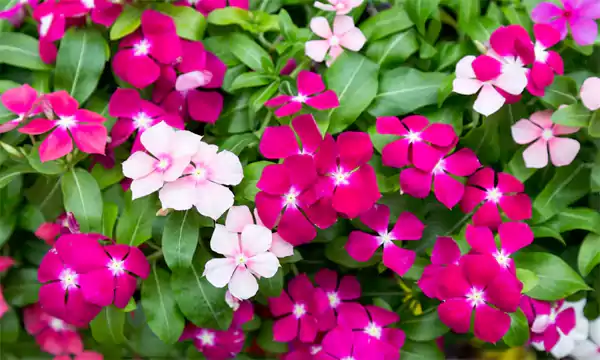
Also known as Madagascar Periwinkle, these five-petaled beauties are a herbaceous perennial species of flowering plant, native and endemic to Madagascar. It is often treated as an annual in many temperate regions due to its sensitivity to cold climates.
This flower supposedly has an ‘eye’, meaning it has one color in the centre core, which fades out to a different color.
Cultivated in many parts of the world, including tropical and subtropical regions like the Americas, Europe, North Africa, and many parts of Asia, it is renowned for its widespread use as an ornamental and medicinal plant.
Significance

Vincas has been embraced for a long time for its various medicinal and ornamental uses. It is also known as the plant of strength, symbolising eternal love, fidelity, friendship, and new beginnings. Have a look at the cultural and historical significance of these flowers.
- In medieval Europe, these flowers were referred to as ‘flower of death’, and included in funeral ceremonies, signifying remembrance and immortality.
- This flower was used by ancient Greeks and Romans in their ceremonial crowns and garlands, implying protection and spirituality.
- According to ResearchGate, traditional Chinese medicine and Ayurveda used these alkaloid-rich flowers to treat various disorders like diabetes, respiratory issues, and cancer.
Did You Know?
According to Greekin, the five petals of Vinca flowers are symbols of faith, hope, charity, peace, and perseverance.
These floral gems have been used for decades and have stood the test of time. Modern-day uses of this five-petaled bloomer are widespread. Continue reading to uncover the further benefits and uses of C.roseus flowers.
Why Vinca Flowers Deserve a Spot in Your Garden?
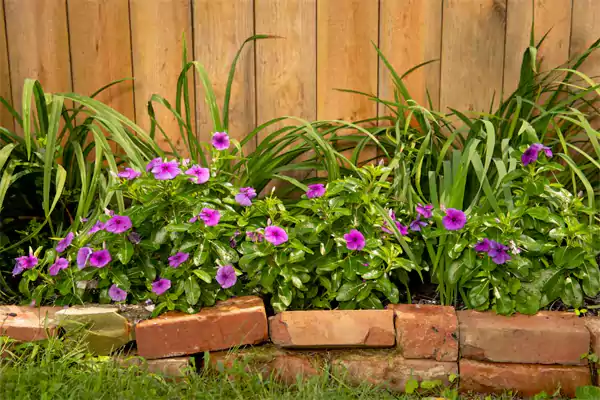
From being a celebrated genus in history to widespread modern-day uses, these blooms have seen a remarkable journey. With its glossy green foliage and star-shaped, vibrant flowers, this garden classic had unlimited benefits beyond its appeal.
Here’s why these flowers truly deserve a spot in your garden.
- Ornamental Uses: It is the perfect choice to transform your home garden into a lively, colourful retreat. Used in multiple landscape settings, be it flower beds, borders, containers, cascading baskets, or a captivating houseplant for sunny corners, it is undoubtedly a garden hero.
For example, try combining Vinca blooms with trailing vine plants to add texture and a long-lasting splash of colors to your space.
- Vibrant Contrast of Colors: One of the outstanding perks of growing these bloomers is the striking contrast of green foliage against vivid blooms. Whether you choose pink flowers, the bold red flowers, white flowers, or the purple and magenta ones, they offer a distinct pop in your boring gardens.
- Low-maintenance and Resilient: These five-petaled beauties are fuss-free and do not require much care and maintenance. It’s hardy and adaptable to a wide range of soil and dry climatic conditions.
All the flora and fauna lovers and gardeners, whether beginner or expert, can indulge in growing them effortlessly.
- Regulates Soil Erosion: Many species of this genus are equipped with ground-covering traits, spreading quickly, filling garden beds, and preventing weeds, which cumulatively help in soil erosion on the banks and slopes.
- Pollination-Friendly: Besides its hassle-free nature, the nectar-rich blooms attract various pollinators like bees and butterflies to your garden. It supports biodiversity by providing a habitat, a source of food supply, and supporting the local pollinator population.
- Medicinal Uses: There are some amazing health benefits of keeping this living plant in your home. As per the National Library of Medicine (NIH), Madagascar periwinkle is an alkaloid-abundant plant and is used in modern medicine to treat cancers.
After being aware of the impeccable benefits, you must be wondering how to incorporate these flowers in your space and elevate your home decor and outdoor living areas with their ineffable charm and long-lasting beauty.
Taxonomic Outline of the Vinca Plant
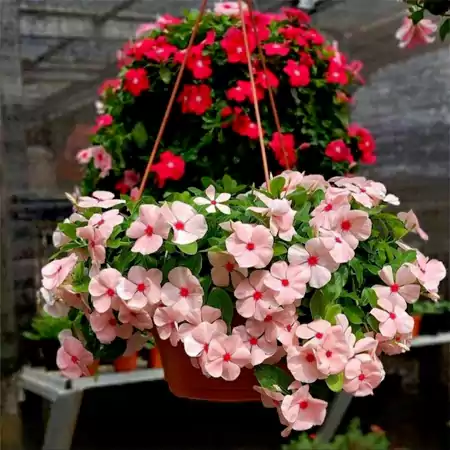
After gaining insights into their beauty and benefits, it is important to understand the botanical background of this genus to appreciate them even more.
Take a close look at the taxonomic outline of these mesmerizing bloomers.
| Taxonomic Outline of Catharanthus roseus | |
| Kingdom | Plantae |
| Clade | Tracheophytes |
| Clade | Angiosperms |
| Clade | Eudicots |
| Order | Gentianales |
| Family | Apocynaceae |
| Genus | Catharanthus |
| Species | C. roseus |
| Plant Type | Herbaceous flowering plant (Annual, Perennial) |
| Common Names | Annual Vinca, Madagascar Periwinkle, Rosy Periwinkle, Running Myrtle, Vinca |
Learning about its botanical history is not just confined to the appreciation of the genus, but also helps acknowledge the value and connection it holds in the Apocynaceae family.
Want Flowering Vinca Plants? Explore the Ultimate Care Guide
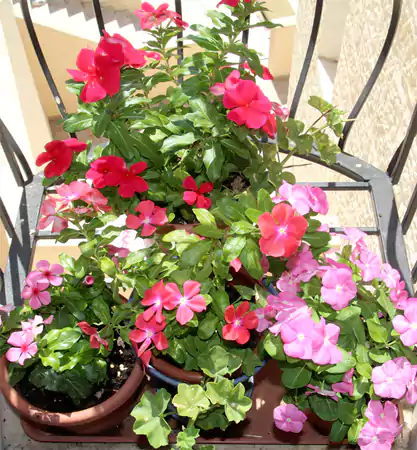
Compared to its other green companions in the same family (Apocynaceae), like Mandevilla, Oleander, Star Jasmine, Periwinkle, or Hoya Plants, Catharanthus roseus shares similar growing and caring needs.
With ideal planting time, optimum conditions, and alternative care, you can achieve a healthy and blooming rosy periwinkle spread. Here’s how to care for and grow these hassle-free, long-lasting bloomers.
| Ultimate Guideline for Vinca Care & Growth | |
| Hardiness |
|
| Light |
|
| Soil Type |
|
| Water |
|
| Temperature and Humidity |
|
| Fertilizer |
|
| Pruning |
|
| Spacing |
|
| Mature Size |
|
Often praised for its long-lasting blooms, these flowers can display a visual interest right from early summer until the first frosts.
It’s such a boon for gardeners who want a low-maintenance blooming plant for more than half a year.
Uncover the Popular Annual Vinca Series for Your Garden
Vinca planting is not restricted to just one type; these species are available in many other series, each differing in terms of colors, growing conditions, features, and garden styles.
Take a look at a few widely cultivated and loved series that can enhance your monotonous gardens to a delightful space.
| Type | Features | Uses |
Cora XDR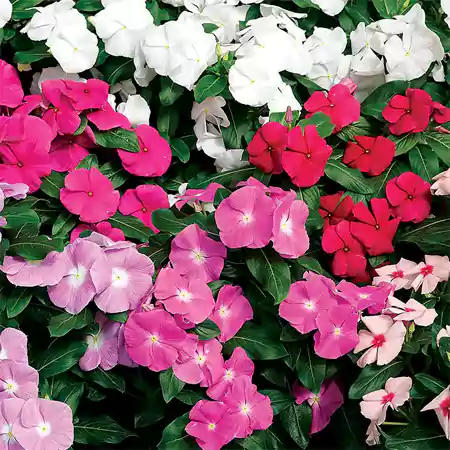 |
|
|
Heatwave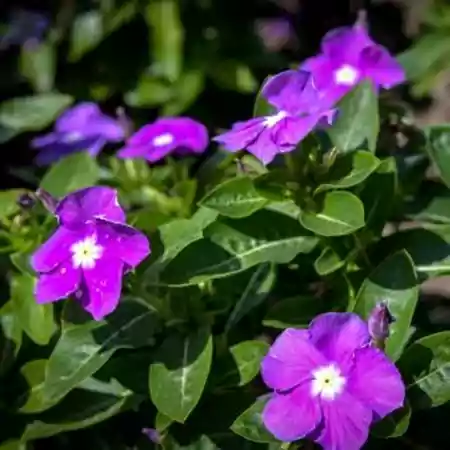 |
|
|
Mediterranean 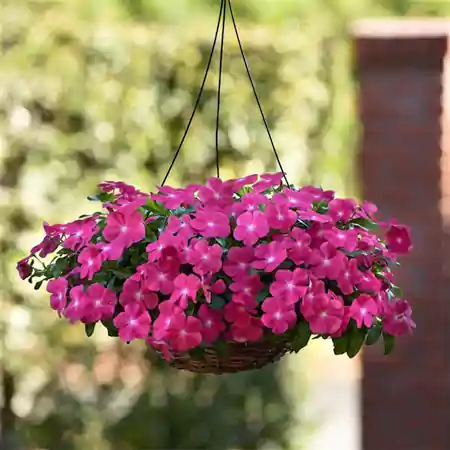 |
|
|
Pacifica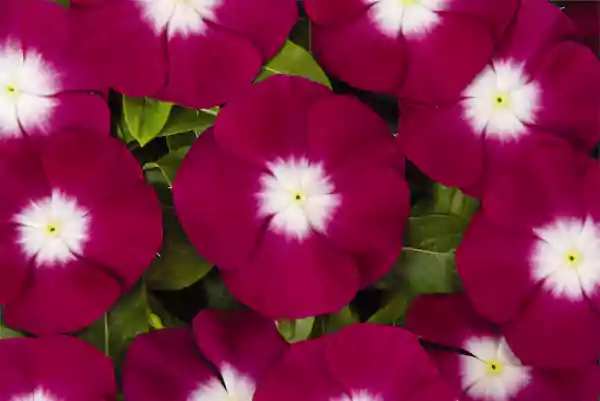 |
|
|
Tattoo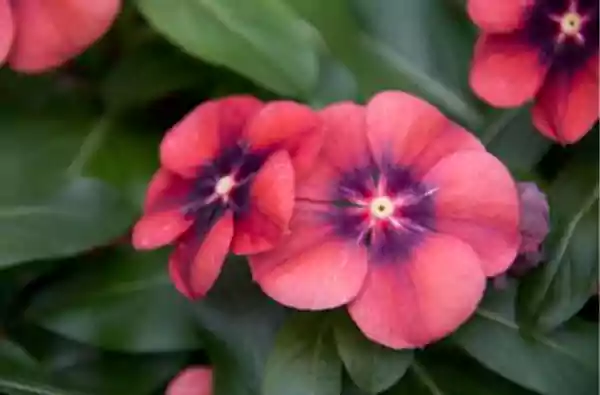 |
|
|
Mega Blooms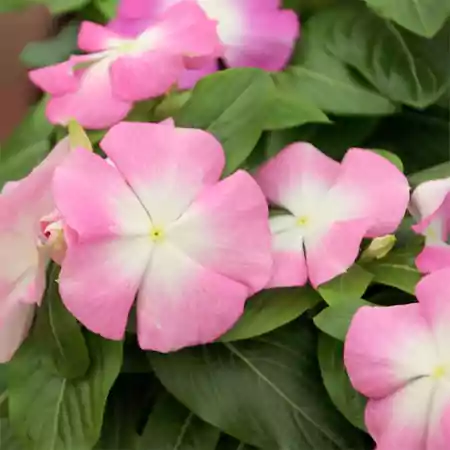 |
|
|
Titan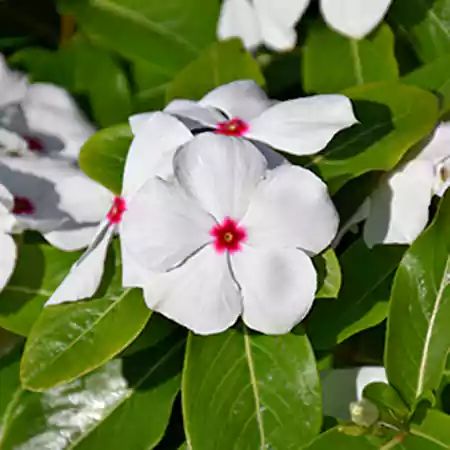 |
|
|
Stardust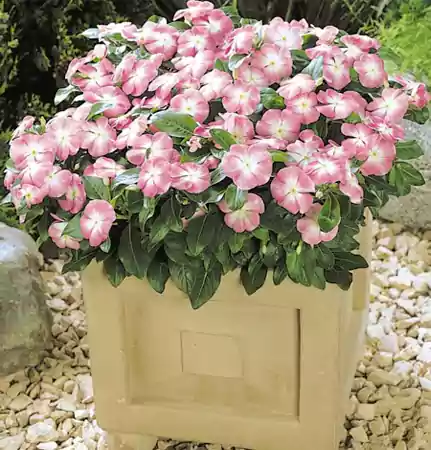 |
|
|
Soiree Kawaii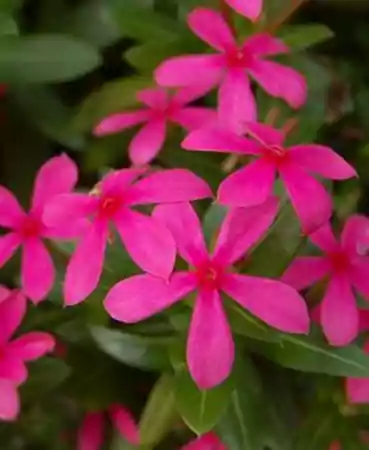 |
|
|
Jams ‘N Jellies Blackberry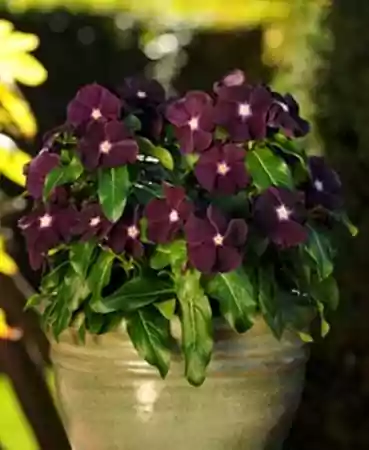 |
|
|
With so many types and varieties, there is a perfect match for every layout. Pick your favourite Vinca series and outshine your garden with color, charm, and allure.
Quick Insight!
Don’t be confused between Vinca and Impatiens. Although they are both flowering plants, but belong to different families and differ in growing and caring preferences.
How to Propagate Vincas Flowers Like a Pro?
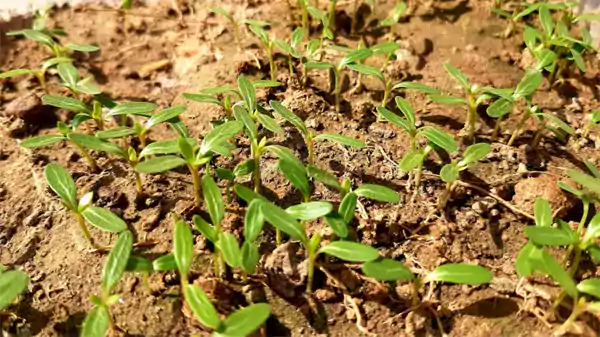
These smooth-textured greens can easily be propagated through stem cuttings. But before you begin, it’s important to know when you can sow the Vinca seedlings.
The best time to germinate these seedlings is when the danger of the last frost date has passed, and the soil has warmed up, typically in late spring or early summer.
Take a look at a few tips on propagating C. roseus like a pro.
- Take the Cutting: Cut 4-6 inches from the branch of a healthy and non-flowering plant. Ensure to use sterilized tools and remove the leaves from the cuttings, if any.
- Rooting: Place the cutting in a jar of water, ensuring the area where you removed the leaves is entirely submerged. The jar should then be located in a spot with bright indirect light.
You can also place the cutting in a well-draining soil mixed with coco peat, garden soil, and sand. Just keep in mind to insert the area where you removed the leaves deep into the soil.
- Keep Changing Water: The water in the jar should be changed from time to time, to keep it fresh and odourless. Add more water to ensure the bottom of the cutting stays immersed.
- Root Development and Transplantation: The roots begin to form within a month, and the cutting can be transplanted into individual pots and containers with a good potting mix. Each pot should ideally be 8 inches wide and 6 inches deep to ensure good air circulation.
- Locate the Plant Under Bright Light: The pots should be placed under bright indirect sunlight to ensure growth in their early phase. Plus, keep a check on the soil moisture and do not let the soil completely dry out.
You can undertake these propagation steps indoors as well, during the early fall, and shift the pot finally outside after all the dangers of the frosts have passed.
What are the Challenges Associated with Vincas? Know the Ultimate Fixes
Madagascar Periwinkle is usually a robust plant with high tolerance to diseases and pests. But it, too, can be affected with occasional fungal and pest infestations.
The main challenge with Vinca care is its watering needs. Majorly, it faces issues because of excess soggy soil conditions, leading to several pesky problems. Let us have a look at some challenges and their ultimate fix.
Leaf Spot
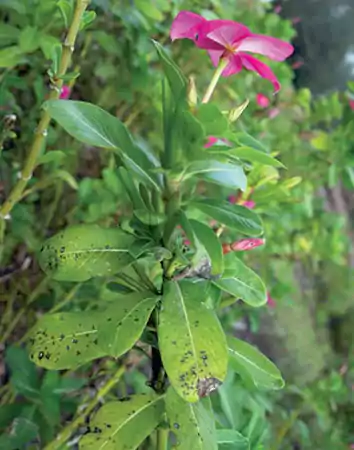
- Cause: Dark brown spots on the leaves, which are often caused by fungal pathogens and result from excessive watering, poor drainage, and lack of circulation.
- Fix: Avoid overhead watering, space them appropriately to ensure good air flow, and ensure good drainage to prevent waterlogging.
Root Rot
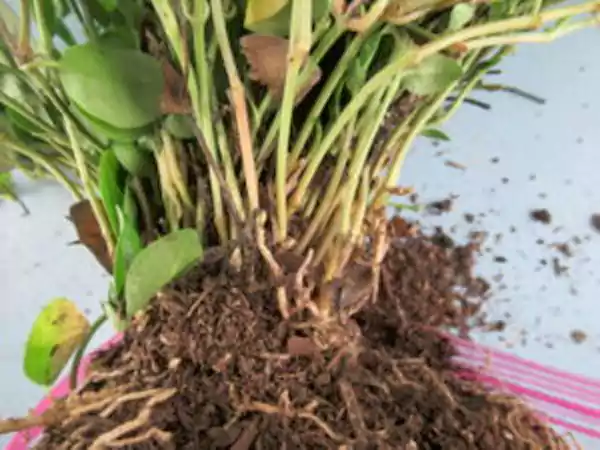
- Cause: Usually, root rot occurs due to overwatering and poor drainage.
- Fix: Avoid overwatering and ensure the pot is equipped with good drainage to prevent water accumulation in the soil.
Yellow and Wilting Leaves
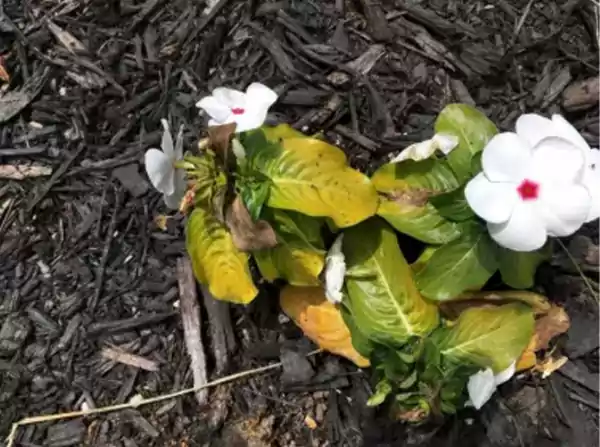
- Cause: Leaves tend to discolor and droop due to overwatering and lack of light.
- Fix: Ensure to water them abruptly and allow the soil to dry out between watering sessions. Provide them with adequate sunlight, as these are sun-loving greens.
Aphids, Spider Mites, and Whiteflies
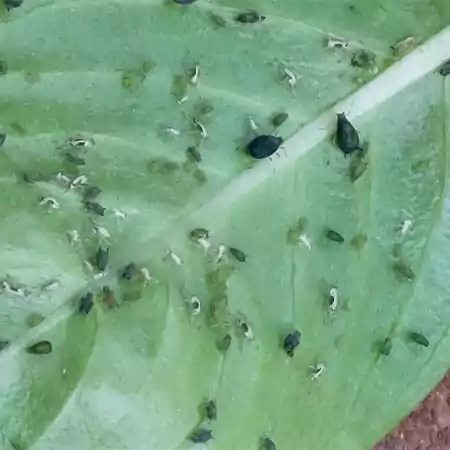
- Cause: These small sap sucking insects are common garden pests that are found beneath the leaves.
- Fix: To get rid of gnats and fungus, use insecticidal sprays and solutions, neem oil, or sometimes even a strong force of water in the infested areas also helps in removing them.
Regularly monitoring them for these infestations and fungal issues, and taking necessary actions, can help you maintain and keep them flourishing in your gardens.
Toxicity Alert!
As per NC State Extension, all parts of C. roseus plants contain a high amount of alkaloids and are considered extremely toxic to humans and pets.
Final Thoughts
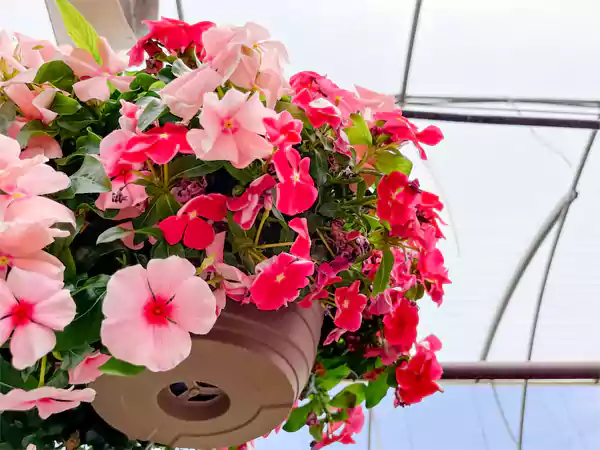
Undoubtedly, the Vinca flower is a beauty with benefits. Tracing its roots from ancient cultures and traditions to impeccable modern-day applications, it has surely stood the test of time gracefully.
Besides the alluring appeal, this multifaceted plant is a powerhouse of benefits and uses. Be it enhancing your garden for all year long, elevating your in-house appeal, or helping you with medicinal properties, it’s pure nature’s bliss.
Whether you are a novice gardener or an expert, its friendly and handy nature is the most likeable attribute.
Take this article as a manual to begin your gardening journey with these marvellous bloomers and turn your place into a colourful and inviting retreat.
Do Madagascar Periwinkle plants come back every year?
These species are not frost-resistant and die during the first frosts. But sometimes, these also reseed themselves and return in the following season.
Is ‘Annual Vinca’ the same as ‘Vinca Minor’ and ‘Vinca Major’?
No, they are not the same. While the annual Vinca belongs to the Catharanthus genus, the other two true Vincas belong to the Vinca genus, and are evergreen ground-covering perennials.
Are the C. Roseus plants toxic?
Yes, these plants are highly toxic to humans and pets.
Can Madagascar periwinkles be kept indoors?
Yes, they can be grown indoors, given they are provided with bright light and warmth.
- Vinca – University of Minnesota Extension
- Catharanthus roseus – NC State Extension
- A Guide for Commercial Production of Vinca – University of Georgia Extension
- A Brief Study on Catharanthus roseus – ResearchGate

